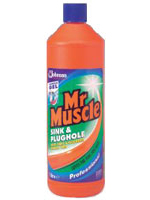 Ingredients
Ingredients-
- Aqua
- Sodium hypochlorite
- Sodium hydroxide
- Alkyl dimethyl, amine N-oxide
- Decanoic acid, sodium salt
- Sodium silicate
- Sodium laurate
- Poly(sodium styrenesulfonate)
- Triethyl phosphate
Published January 2011
Blocked drains are often caused by congealed fat and this can be attacked chemically with a strong alkali like sodium hydroxide which breaks the fat down into fatty acid salts and glycerol and these are water soluble. Whether this product can "unblock in 15 minutes" depends of course on the amount of fat that has to be dissolved.
Ingredients
Sodium hypochlorite (aka bleach, NaOCl) is powerful enough to destroy all the microbes in the blockage. It is made from chlorine gas and sodium hydroxide, and has been used as a disinfectant for more than 100 years. In World War I it was used to disinfect wounds and prevent gangrene, and known as Milton solution. Mothers used it to sterilise feeding bottles for babies. Today sodium hypochlorite is used for neither purpose. An unexpected use of bleach is in oil wells, where it is needed to sterilise the water that is pumped down the well in order to force up more oil. If the water is not sterile it allows slime moulds to grow, just as occurs in drains, and these clog up the oil-bearing strata making extraction difficult.
Sodium hydroxide (aka caustic soda, NaOH) is a powerful and corrosive alkali that removes congealed fats by reacting with them chemically. Fats consist of a glycerol molecule to which are attached three fatty acid chains and the sodium hydroxide severs the chemical bonds between them. In so doing it produces water-soluble components, namely: glycerol and the sodium salts of the fatty acids. These can then be flushed away. Sodium hydroxide is produced on a massive scale for the chemical industry and is needed for the production of aluminium, soap, wood pulp, and biodiesel. Old paint can be stripped from wood by immersing it in a bath of sodium hydroxide solution.
Alkyl dimethyl amine N-oxide (here the term alkyl refers to hydrocarbon chains 10 to 16 carbons long, and these are attached to a nitrogen atom which also carries two methyl groups (CH3) and an oxygen atom). This is a non-ionic surfactant and capable of making grease and fats soluble in water. It is also used in shampoos and bubble bath formulations.
Decanoic acid, sodium salt (aka sodium caprate, formula CH3(CH2)8CO2Na) is an anionic, i.e. negatively charged, surfactant, and as such will attack grease aggressively.
Sodium laurate (aka sodium dodecanoate, formula CH3(CH2)10CO2Na) is also an anionic surfactant.
Sodium silicate (aka water glass, formula Na2SiO3) acts to make the drain unblocker gel like. It also prevents corrosion of metals components in the sink and drain. When a paste of sodium silicate is applied to a leaking car exhaust it will do an emergency repair job and firmly seals the hole as it dries out.
Poly(sodium styrenesulfonate) is a ionic polymeric material that is soluble in water and also helps form the gel. It will also pick up metal ions such as calcium which may be present as limescale.
Triethyl phosphate (formula (CH3CH2O)3PO) acts as a powerful solvent for all kinds of materials and dissolves components of the blockage. As a pure liquid it can be used as a paint-stripper.